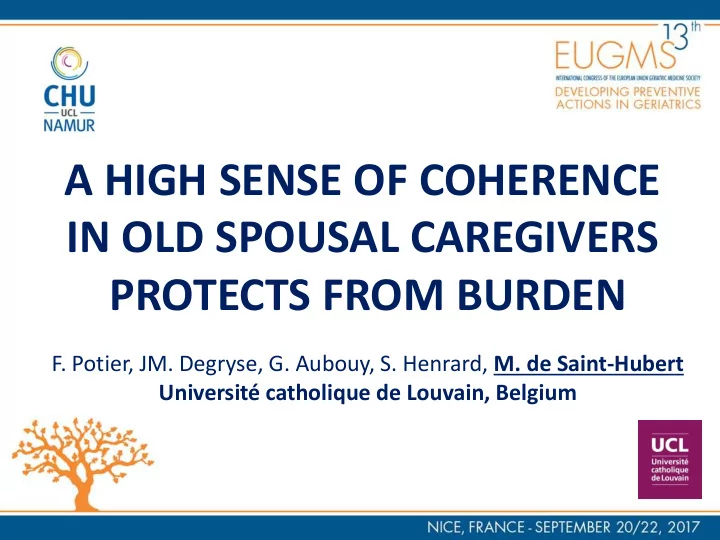

A HIGH SENSE OF COHERENCE IN OLD SPOUSAL CAREGIVERS PROTECTS FROM BURDEN F. Potier, JM. Degryse, G. Aubouy, S. Henrard, M. de Saint-Hubert Université catholique de Louvain, Belgium
CONFLICT OF INTEREST DISCLOSURE I have no potential conflict of interest to report
Introduction • Old caregivers in geriatric medicine • Sense of coherence – Salutogenesis vs pathogenesis – Focus on factors that support health and well- being, rather than on factors that cause disease
Sense of coherence Comprehensibility Manageability Meaningfulness SOC Flexibility, reaction, recruitment of resources Protection from negative health outcomes: Perceived health, QOL, mortality, and disability
Objective & methods • CAREGIVER² : cohort study – Associations between SOC, positive affects, depression and the burden experienced by older caregivers – Recruitment via geriatric day hospital (caregiver > 69y), GP – Measures – Cross sectional analysis – Stat : stepwise logistic regression, correlations
Results Caregivers (n=79) Care-receiver • Mean age 79.4±5.3 • Mean age 81.6±5.3 • 53% women • Cognitive imprment: 82% • Zarit: 32/88 (moderate) • Median Katz 1.5/6 • Caregiving: source of self-fulfillment (66%) • SOC: 64.8+/-10.3
Factors associated with a higher caregiver burden Univariate analysis Multivariable analysis Variable OR (95%CI) p-value OR (95%CI) p-value Age, years 0.87 (0.79 - 0.96) <0.01 0.87 (0.76 - 0.98) 0.03 Gender, male 0.59 (0.23 - 1.47) 0.26 SOC quartile sup 0.15 (0.05 - 0.43) <0.01 0.18 (0.04 - 0.65) 0.01 GDS>5 4.17 (1.36 - 15.76) 0.02 3.40 (0.87 - 16.37) 0.09 NPI quartile sup 3.22 (1.04 - 12.26) 0.06 2.90 (0.71 - 14.90) 0.16 Supervision >2 h/d 4.05 (1.24 - 14.66) 0,02 Perturbed sleep 2.9 (1.09 - 8.46) 0.04 KATZ>8/24 4.90 (1.76 - 14.59) <0.01 8.69 (2.28 - 40.46) <0.01
Characteristics associated with a higher SOC? Univariate analysis Multivariable analysis Variable OR (95%CI) p-value OR (95%CI) p-value Age, years 1.12 (1.02 - 1.24) 0.02 1.09 (0.98 - 1.21) 0.11 GDS >5/15 0.27 (0.07 - 1.02) 0.05 0.29 (0.06 - 1.06) 0.08 Self-esteem >3/5 3.69 (0.98 - 13.99) 0.05 3.035 (0.792 - 16.12) 0.09 Perturbed sleep 0.35 (0.11 - 1.08) 0.07 • Socio-economic status, gender, medical characteristics NS • SOC- 13 & depression (Pearson’s R =-0.47) – Different constructs
Discussion • Higher SOC: protective factor >< burden Andren & Elmstahl, 2008; Matsushita et al., 2014; Stensletten, Bruvik, & Drageset, 2014) • Caregiving as a source of self-fulfillment (66%) • Limitations : – Cross-sectional, size, convenience sample – SOC & depression Boeckxstaens et al., 2016 – Influence of caregiver status on SOC • Decrease with long-lasting caregiving Valimaki et al., 2009
Perspectives • Higher SOC & good health outcomes in caregiver Successful home-care for the care-receiver • Further research about caregivers’ strengths instead of only their vulnerability • Role of health providers: – Recognize expertise and the meaning – Enhance positive reactions • Interventions should help caregivers focus on the positive aspects of providing care and enhancing their feelings of competence • Susceptibility to change? Kasapis C et al, J Am Coll Cardiol 2005;10:1563-9 Colbert LH et al, JAGS 2004;52:1098-1104 (transv)
SOC is not an inverse measure of depression Socio-demographic and health variables SOC GDS (N=79) Gender # 0.11 -0.08 Age ## 0.28* -0.11 Socio-economic score ## 0.23* -0.18 Burden ## -0.23* 0.22 SPPB ## -0.001 -0.13 Nutrition ## 0.14 -0.14 Frailty ### -0.12 0.21 Notes. #: biserial correlation, ##: Pearson’s correlation, ### polyserial correlation *: p <0.05
Recommend
More recommend